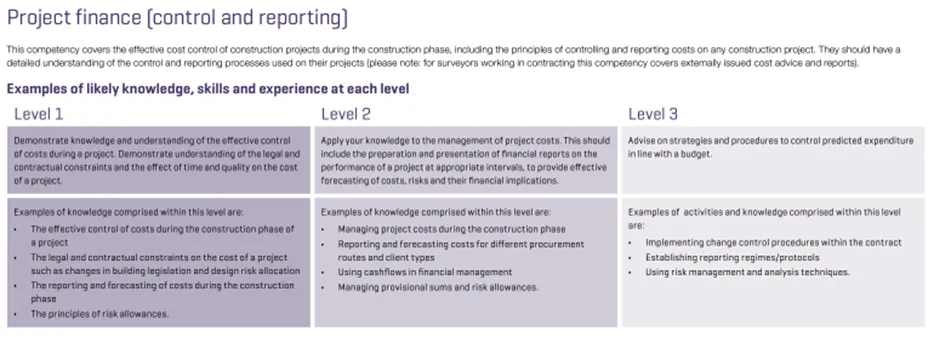
RICS APC: Project Finance (Control and Reporting)
This week’s focus is project finance (control and reporting). Given the construction industry’s tendency to overspend against budget, our role in control and reporting project finance is crucial and, arguably, if the industry is to deliver better value, then it needs to improve.
The Definition
Project finance (control and reporting) is defined as ‘the effective cost control of construction projects during the construction phase, including the principles of controlling and reporting costs on any construction project. The candidate should have a detailed understanding of the control and reporting processed used on their projects (please note: for surveyors working in contracting this competency covers externally issued cost advice and reports’.
A snapshot of the competency description from the pathway guide is provided at Figure 1, where you will see what is required of you at level 1, level 2 and level 3. At your APC assessment, you need to demonstrate that you have achieved level 3 competency.
Figure 1

Remember: level 3 is advising; level 2 is doing; and level 1 is knowing. What constitutes advice? The Oxford English Dictionary defines advice as ‘guidance or recommendations offered with regard to prudent future action’.
For me, in the context of the APC, this means there was an issue, and you used your professional judgement to understand the issue and recommend to your client or your employer as to the action which should be taken.
Let’s explore this further with some hypothetical examples of project finance (control and reporting).
Level 3, Bullet 1
At level 3, you are required to demonstrate that you can competently ‘implement change control procedures within the contract’.
In its purest form, at least at levels 1 and 2, this should be relatively straightforward. You need to know you contract, the provisions relating to change (variations) and show how you have implemented procedures to ensure you comply with the requirements of the contract.
The level 3 advice might not be that straightforward because, ultimately, if you are complying with the contract then what advice is needed? I would say this relates to advising your project team on what they need to do to comply with the provisions of the contract. You might implement controls over and above the contract to ensure change is captured at source (e.g. by engineers) and flagged with the commercial team to act by administering the contract.
Another area of advice might be challenging time bar provisions and giving advice to the team about how compliance can be achieved without bringing the project to a standstill. This will require an understanding of the operational implications and the contractual implications, and devising a change control approach which satisfies both.
Level 3, Bullet 2
At level 3, you are required to demonstrate that you can competently ‘establish reporting regimes/protocols’.
This is another that is written more at a level 2 level in that establishing reporting regimes/protocols would, arguably, demonstrate doing rather than advising.
What I would look to do here is demonstrate that you understand project financial reporting, both to your business and your client. You should demonstrate how you ensure those financial reports are robust by following a regime/protocol that ensures the correct information is collected at the right time to output high quality reports.
Then, for me, the report itself is advice. You are letting you business or client know the financial position, what has changed and what you are concerned about. If you are doing this correctly, it should be forward looking rather than telling people what has happened. This allows businesses or clients to understand the direction of travel and take your advice as to the steps they can take to take avoid a cost overspend.
Level 3, Bullet 3
At level 3, you are required to demonstrate that you can competently ‘use risk management and analysis techniques’.
In some ways this connects to my point in the previous section. How do you analyse risk? How do you show that you understand where the risks and opportunities are and demonstrate that you can lead a team to avoid the risks and secure the opportunities?
I don’t think you would achieve this by running a Monte Carlo simulation. In my view, you would demonstrate this by showing you understand the status of the design progress, the issues in procurement and the challenges in operational delivery.
You would show that you can convert those issues into numbers and show people what the risk means. It’s that advice which allows your stakeholders to understand the risk and think about what can be done differently.
The analysis and management and risks, at the foundation level, starts with understanding the risks allocated to your business in the contract. That should be a given, but don’t miss that important step.
Final Reflections
This competency connects together a quantity surveyors need to understand issues, what those issues mean in monetary terms and what might improve the situation. This is achieved through robust processes that convert issues into numbers and allow your business or your client to make informed and proactive decisions about the course of action to take.
The outcome from this, if it is done successfully, is avoiding the unnecessary expenditure of costs, and that is what I would be looking for as an assessor. There is a client care aspect to this too, and that shouldn’t be understated.
In next week’s article, we will look at quantification and costing (of construction work). Keep an eye out for that and, in the meantime, enjoy the rest of your week!
Bringing The science of Quantik® to you
p.s. If anything in this article, or any of our articles, resonates with a challenge you are experiencing, check out our ‘Bringing The science of Quantik® to you’ initiative where we offer a tailor-made session aimed at helping you tackle your project or business challenge (link below).
Form: https://form.jotform.com/241425931072350
Form: https://form.jotform.com/241425931072350
Back to articles
THE SCIENCE OF QUANTIK™
Publications
We publish insights through our LinkedIn newsletter, titled “The science of Quantik”, which are light bites of information covering news and insights relating to the construction industry and quantity surveying.
LinkedIn